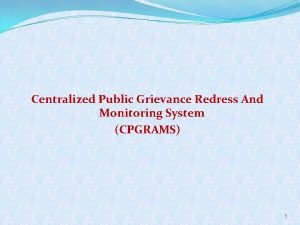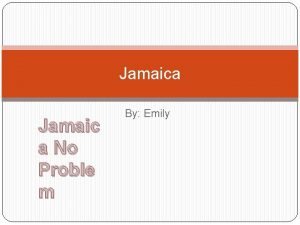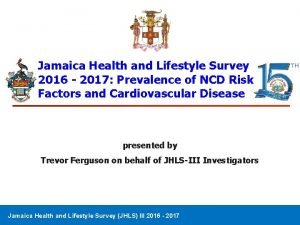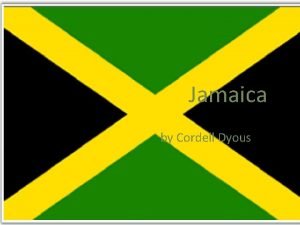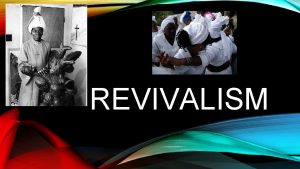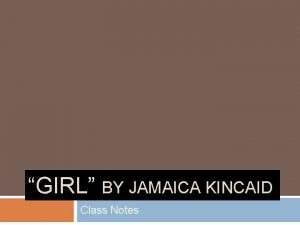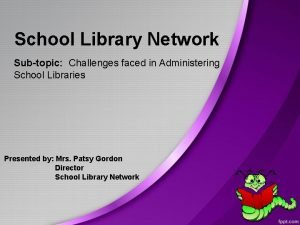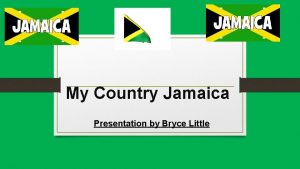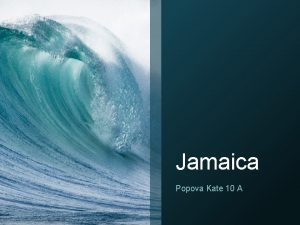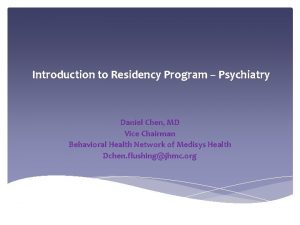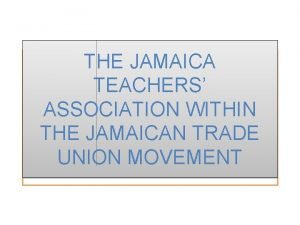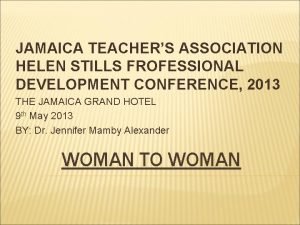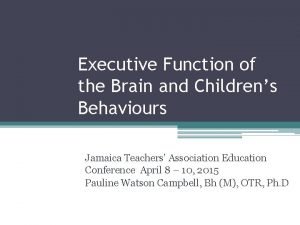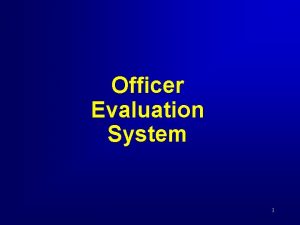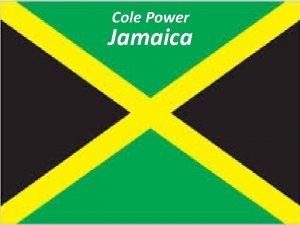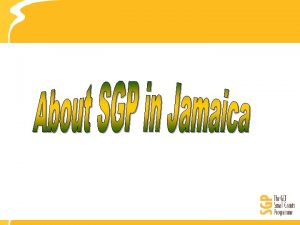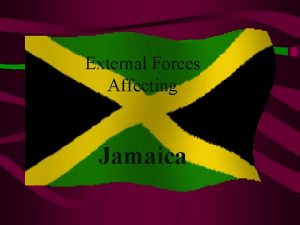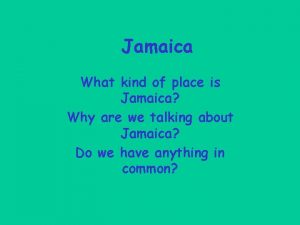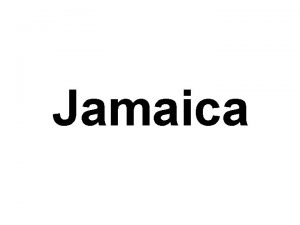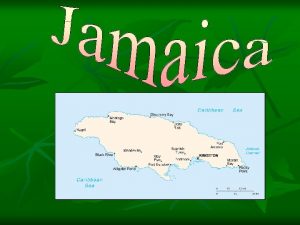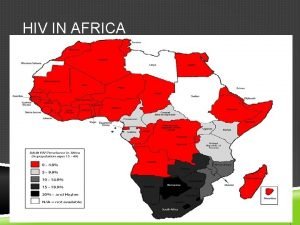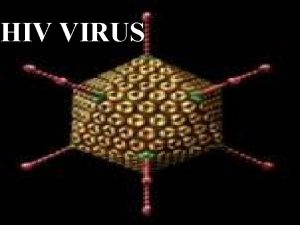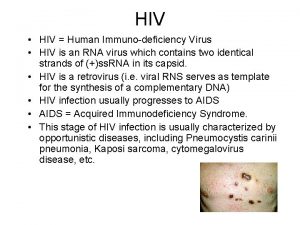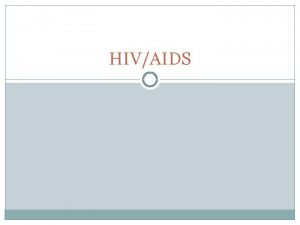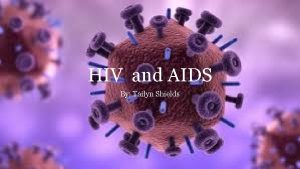Jamaica AntiDiscrimination System For HIV SENIOR REDRESS OFFICER




































- Slides: 36

Jamaica Anti-Discrimination System For HIV SENIOR REDRESS OFFICER: Nadine Lawrence

WHAT IS JN+ § § An advocacy organization operated for and by Persons Living with HIV (PLHIV) An Umbrella organisation of support groups for persons living with HIV and AIDS (PLHIV) – services include: empowerment, resource mobilization and partnership. WHO OPERATES JN+? § PLHIV Board of Directors, Secretariat Staff and Members § Today JN+ is the only PLHIV Network in Jamaica, which Advocates for the rights of persons living with and affected by HIV and AIDS. 2

WHAT IS J. A. D. S? Jamaica Anti-Discrimination System for HIV • JADS is a system that collects complaints of HIV-related discrimination and Gender Base Violence (GBV) and refers them to the appropriate entities for redress. 3

About the J. A. D. S • The first complaint was documented through JN+ in 2005 • Initially known as NHDRRS, it was formally established in 2007 with funding from USAID and the Ministry of Health • The Enabling Environment and Human Rights Unit of the National Family Planning Board provides financial and technical support to the system • The JADS is guided by a Steering Committee consisting of multisectoral partners • There was a launch for the rebranding of the system in November 2017. • The New name for system would be now known as Jamaica Anti 4 Discrimination System for HIV (J. A. D. S)

JADS IS GUIDED BY A STEERING COMMITEE • • • • The Jamaican Network of Seropositives (JN+) National Family Planning Board, EEHR Unit (NFPB) Health Policy Plus (HP+) UNAIDS Jamaica AIDS Support for Life (JASL) Ministry of Health, Client Complaint Mechanism (CCM) Ministry of Labour & Social Security (MLSS) The Office of the Public Defender of Jamaica (OPD) Caribbean Vulnerable Communities (CVC) Jamaica Constabulary Force (JCF) Jamaicans for Justice (JFJ) Community Representative (PLHIV) Norman Manley Law School Kingston Legal Aid Clinic 5

WHAT IS STIGMA? Negative thoughts, beliefs, and attitudes about a person or a group of persons because of a particular trait or characteristic. ” • “ 6

WHAT LEADS TO STIGMA q. Pre conceived ideas: §what is norm §what is accepted §What is not accepted 7

IDENTIFYING STIGMA Stigma is expressed in behaviours ranging from: • Gossip • Suspicion • Isolation • Rejection • Abuse & violence • Harassment • Rude behaviour 8

EFFECTS OF STIGMA Some of the effects of stigma include: • Depression, loneliness, rejection, hopelessness & self-doubt • Shame & loss of confidence • Denial “Stigma forces the epidemic underground, creating the ideal conditions for HIV to spread. ” (Aggleton et al. , 2003: 1) 9

WHAT IS DISCRIMINATION? “Unjust or unfair behaviour resulting from stigmatizing thoughts, beliefs, and attitudes about a person or group of persons. ” 10

HIV-RELATED DISCRIMINATION Enacted stigma becomes discrimination. Examples of discrimination experienced by persons living with HIV include: • • • Breach of confidentiality Denied employment Harassment/Verbal abuse Denied access to healthcare Forced to leave home/community Physical violence 11

TWO CATEGORIES OF DISCRIMINATION 12 1. LEGISLATIVE Stigma reflected in law or policy, for example: The Occupational Safety and Health Bill (OSH) in place so persons will know how operate in a workplace and feel protected The National HIV/AIDS Workplace Policy protect individuals from being discriminated with in the workplace 2. COMMUNITY Stigma in less formal contexts, such as: Family Workplace Social settings § Local community , marketplace, sports centre

FACTS & FIGURES 357 • cases collected between 2005 to 2018 13

SETTINGS OF DISCRIMINATION COMMUNITY HOME HEALTHCARE WORKPLACE POLICE CHURCH 14

INCIDENTS BY AGE GROUP 15 -19 7% 20 -24 6% 25 -29 11% 30 -34 35 -39 10% 14% 40 -44 45 or older 14% 12% 15 Not Available

INCIDENTS BY PARISH Total 2%3% 6% 21% 17% 5% 7% 4% 9% 9% 5% 5% 5% 2% 16 Kingston St Andrew St Catherine St Thomas Clarendon Trelawny St Mary Manchester St James St Elizabath St Ann Portland Hanover Westmoreland

INCIDENTS BY SEX 63% 35% 1% 1% 17

KEY TAKEAWAYS COMMUNITIES are the MOST commonly reported setting for incidents of discrimination. • Community education and sensitization initiatives are critical to 18 promote accepting attitudes towards people living with HIV.

HEALTHCARE FACILITIES are the Second most commonly reported setting for incidents of discrimination. Reduces access to treatment, care, support, and prevention 19

FEMALES experience or report incidents of discrimination twice as often as males. Males may be more reluctant to report incidents of discrimination, or may not be as aware of the JADS or any other services 20 that exist

JADS: FIVE MAIN STEPS COMPLAINT REPORT INTERVIEW WITH COMPLAINANT INVESTIGATION CASE CLOSURE REDRESS ENTITY INTERVENTION 21

STEP 1: Submit complaint report • Who should file the complaint? ◦ Persons experiencing discrimination ◦ Witnesses to discrimination Where can the complaint be reported? ◦ JN+: in-office, online at jnplus. org or by phone at 929 -7340/839 -8000 ◦ Jamaica AIDS Support for Life, C. H. A. R. E. S, J-FLAG, Children First, Client Complaint Mechanism at all Regional Health Authorities ◦ Adherence counsellors & social workers at treatment sites ◦ JN+ Community Facilitators with in the regions How does JADS ensure confidentiality? ◦ Governed by a confidentiality policy and each incident is assigned a unique code in the database 22

STEP 2: Interview • Who conducts the interview? ◦ Redress Officers with in JN+ conduct interview with complainant/person experiencing discrimination • What is the purpose of the interview? ◦ To provide detailed information about the incident ◦ To establish a course of action desired by complainant for pursuit of redress • Possible courses of action (dependent on complainant’s wishes): • ◦ ◦ ◦ ◦ Receive an Apology Referral for Social Assistance Received Counseling Conflict Resolution Referral for medical Care Legal representation Report to Police No Action (I just want to file a report) 23

STEP 3: Review Panel • Who leads the Review Panel ◦ Review Panel (made up of representatives from entities that have a mandate to provide redress) ◦ External authority such as (Ministry of Health Complaint Management System, Ministry of Labour &Social Security, Jamaica Constabulary Force, Office of the Public Defender, Jamaicans for Justice, Ministry of Education Youth & Information, Bureau of Gender Affairs, Pharmacy Council and Norman Manley Law School Kingston Legal Aid Clinic) • What is the purpose of the Review Panel? ◦ To examine detailed information of the case ◦ To determine the validity of accusations • Advancement to next steps depends on: ◦ Complainant’s wishes ◦ Merits of case ◦ Redress options available 24

STEP 4: Redress Intervention Who are the redress entities? ◦Office of the Public Defender • What are the different types of redress available? ◦Ministry of Health: Complaint Managemet System ◦Ministry of Labour and Social Security ◦Ministry of Education Youth & Information ◦Jamiacans fo Justice (JFJ) ◦Pharmacy Council ◦Jamaica Constabulary Force ◦ Receive an Apology ◦ Receive Social Assistance ◦ Counselling ◦ Conflict Resolution ◦ Legal Representation ◦ Intervention/Sensitization ◦ Referral for Medical Care 25

STEP 5: Closure • Reasons for case closure: 1. Complainant cannot be reached to complete interview 2. Complainant requests, at any time, to close the case 3. Investigative team recommends case closure 4. Redress intervention is complete 26

REDRESS OFFICERS § 3 Redress Officers employed to JN+ (Southeast/Southern, Northeast and Western Regions ) § They collect complaints of HIV-related discrimination & gender-based violence across Jamaica § The Redress Officers aim to educate PLHIV’s about Human Rights violations and what redress options are available § They are trained in paralegal studies and can provide preliminary guidance to those wanting to pursue legal action 27

REPORTING • Non-identifying information from the complaint is shared with: ◦ Ministry of Health Monitoring & Evaluation Unit ◦ Stakeholders ◦ Civil society organizations ◦ Government agencies ◦ PLHIV community ◦ Researchers ◦ UWI Repository 28

WHY DO WE NEED THE JADS? 29

FOUR REASONS To empower people living with and affected by HIV and AIDS To evaluate laws & institutions To identify gaps for law revision To increase accountability To measure the effectiveness of initiatives, and to design new ones 30

SUCCESS STORies • JANE’S APPLICATION PROCESS TO NURSING SCHOOL Entry requirements for admission into the programme included: • An interview, which Jane successfully passed • A series of health-related blood tests, including an HIV test 31

JANE DID NOT WANT HER HIV STATUS TO BE KNOWN • She contacted a representative from the Regional Health Authority to ask if “HIV testing was necessary”; they confirmed that it was not • But the administrator of the Nursing School insisted that HIV testing was mandatory for enrolment to protect the health of future student • Jane filed a complaint with the J. A. D. S to report this incident of HIV-related discrimination 32

THE MOH SENT A LETTER EXPLAINING THAT THERE IS NO MEDICAL JUSTIFICATION FOR AN HIV TEST AS A PRE-REQUISITE FOR ENTRY INTO ANY FIELD OF STUDY • Supported by policies from the Ministries of Health, Ministry of Education and Ministry of Labour & Social Security • The Letter demanded that the institution immediately discontinue the practice of requiring HIV testing as a condition of entry into their programmes ADD A FOOTER 33

THE SCHOOL’S BOARD OF DIRECTORS MET AND AGREED TO REMOVE HIV TESTING FROM THEIR ENTRY REQUIREMENTS An updated medical report form was sent to the J. A. D. S to validate the Board of Directors’ statement 34

As a result of Jane’s courageous actions, no other student will be subject to this discrimination when applying for admission into this academic institution BIG UP, JANE! 35

THANK YOU! Any questions? Contact us At (876) 929 -7340/839 -8000 Email & Website jnplus@hotmail. com www. jnplus. org
 Cpgrams
Cpgrams Andrew youngson
Andrew youngson Declaration writing
Declaration writing Jamaica famosos
Jamaica famosos No proble
No proble Jamaica hope cattle
Jamaica hope cattle Jamaica health and lifestyle survey 2019
Jamaica health and lifestyle survey 2019 Continent jamaica
Continent jamaica Intro
Intro Glamour tours montego bay jamaica
Glamour tours montego bay jamaica Development order jamaica
Development order jamaica Poco church in jamaica
Poco church in jamaica Tourism reducing the development gap
Tourism reducing the development gap What is the setting of girl by jamaica
What is the setting of girl by jamaica Eland jamaica
Eland jamaica Wwoof jamaica
Wwoof jamaica Challenges faced by school libraries
Challenges faced by school libraries Fekete bika pata
Fekete bika pata My country jamaica
My country jamaica Jamaica 5 themes of geography
Jamaica 5 themes of geography Jamaica hospital psychiatry
Jamaica hospital psychiatry Language
Language Bank of jamaica address
Bank of jamaica address Bank of jamaica address
Bank of jamaica address What is a good business to start in jamaica
What is a good business to start in jamaica Jamaica
Jamaica Analytical thesis statement
Analytical thesis statement Jamaica teachers association logo
Jamaica teachers association logo Jamaica teachers association
Jamaica teachers association Manufacturing industry in jamaica
Manufacturing industry in jamaica Jamaica teachers association logo
Jamaica teachers association logo Engineering schools in jamaica
Engineering schools in jamaica Jamaica civil aviation authority contact
Jamaica civil aviation authority contact Lexisnexis desk officer reporting system
Lexisnexis desk officer reporting system Officer evaluation system
Officer evaluation system Officer evaluation system
Officer evaluation system Fspos
Fspos
